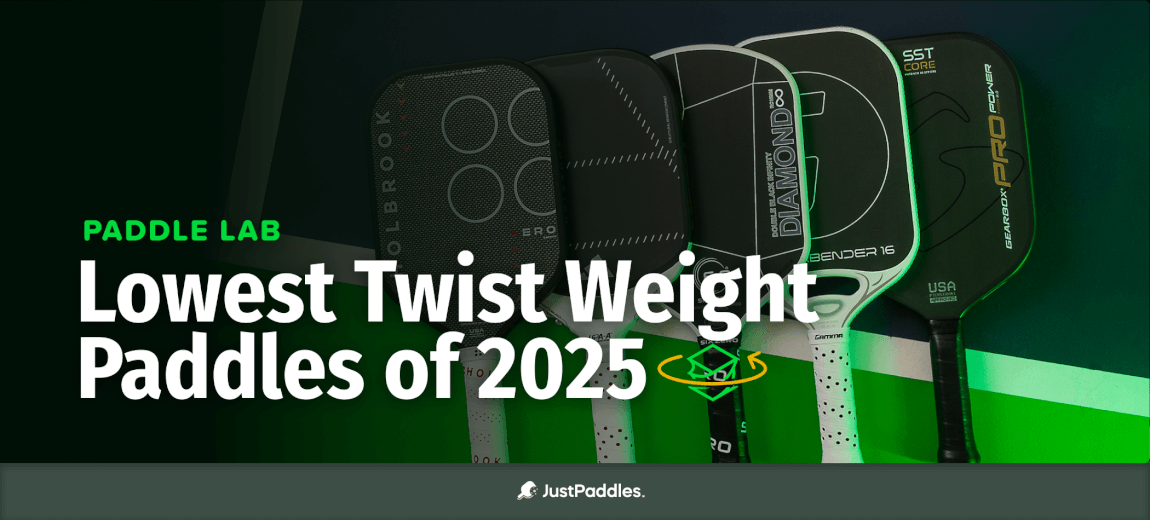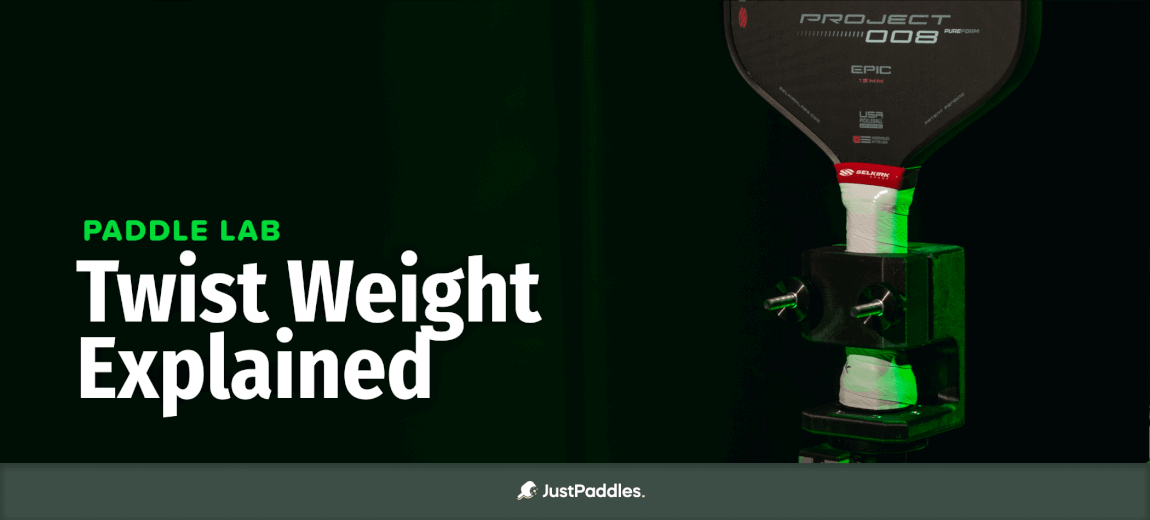Looking for lightning-fast hands at the net? Sometimes less is more, especially when it comes to twist weight. While high twist weight paddles offer stability and forgiveness, low twist weight paddles deliver better speed, maneuverability, and quick reactions that can make all the difference during rapid exchanges.
Thanks to Paddle Lab, we've tested hundreds of paddles to measure twist weight objectively. These numbers show you which paddles offer the quickest handling and most responsive feel for players who prefer speed over stability.
What Is Twist Weight?
Twist weight measures how much a paddle resists twisting when you hit the ball away from the center. But a lower twist weight doesn’t mean the paddle is weaker than those with a higher twist weight. It's a different performance characteristic that benefits certain playing styles.
Lower twist weight means the paddle is easier to maneuver and swing quickly. While it offers less resistance to twisting on off-center hits, it compensates with lightning-fast handling and effortless swing speed that's perfect for rapid-fire exchanges at the net.
How We Test Twist Weight (Why We Use oz·inch²)
Our Paddle Lab uses specialized equipment to calculate twist weight accurately across all paddles. We measure twist weight in oz·inch², a unit that reflects how the paddle's mass is distributed and how it resists rotation.
Lower values indicate paddles that are easier to swing quickly and maneuver rapidly. This quicker handling translates to faster reaction times during kitchen line battles and easier paddle positioning during fast exchanges.
The oz·inch² measurement accounts for both the paddle's weight and how that weight is positioned. A lighter paddle or one with weight concentrated toward the handle will typically have lower twist weight than heavier paddles with mass at the edges.
Want to dive deeper into how we test twist weight? Check out our blog!
Why We Test Twist Weight
Understanding twist weight helps players choose paddles that match their playing style. While high twist weight offers stability and forgiveness, low twist weight has different advantages:
- Speed: Lower twist weight paddles swing faster with less effort. This quick handling is crucial during rapid exchanges where split-second reactions determine who wins the point.
- Maneuverability: These paddles are easier to position quickly, making them ideal for players with excellent hand-eye coordination who can consistently find the sweet spot.
- Lighter Feel: Even if two paddles have similar static weight, lower twist weight creates a lighter, more responsive feel in motion.
What Player Uses a Low Twist Weight Paddle?
Low twist weight paddles do well in specific playing situations and for certain player types:
Doubles Players: If you spend most of your time at the net in fast kitchen exchanges, low twist weight gives you the quick hands needed to react and counter during rapid-fire volleys. The ability to reposition your paddle instantly matters more than stability on occasional mishits.
Finesse Players: Players who rely on touch, placement, and quick hands over raw power benefit from the responsive feel of low twist weight paddles. You can make subtle adjustments and execute delicate shots more easily.
Players with Strong Technique: If you consistently make solid contact and rarely hit off-center, you don't need maximum forgiveness. Low twist weight lets you maximize speed and maneuverability without sacrificing much.
Quick-Reaction Players: During fast exchanges where you're blocking hard shots or countering at the net, the split-second advantage of a quicker-swinging paddle can be the difference between making or missing the shot.
In practical terms, imagine you're at the kitchen line in a fast dinking rally. Your opponent suddenly speeds up the ball. A low twist weight paddle lets you get your paddle in position faster, giving you a better chance of making a solid block or counter.
The Lowest Twist Weight Paddles
Based on our Paddle Lab testing, these paddles currently have the lowest twist weight measurements.
1. Six Zero Infinity Edgeless Double Black Diamond Control 16mm Carbon Fiber Pickleball Paddle
3. Selkirk VANGUARD Power Air Invikta Carbon Fiber Pickleball Paddle
4. Franklin C45° Hybrid Carbon Fiber Pickleball Paddle
5. CRBN¹ TruFoam Genesis Carbon Fiber Pickleball Paddle
Finding Your Ideal Twist Weight
Low twist weight data shows you which paddles offer the quickest handling, but the right choice depends on your playing style and technical ability. Lower twist weight delivers speed and maneuverability which is ideal if you have good technique and rarely hit off-center.
Think about your game honestly. Do you consistently make solid contact, or do you frequently hit across different parts of the paddle face? Are you primarily a net player in fast exchanges, or do you play more baseline-oriented points? Doubles players and finesse players typically benefit most from lower twist weight, while beginners or power players might prefer higher twist weight paddles.
Use these numbers alongside other metrics like exit velocity, swing weight, and consistency to build a complete picture of how each paddle performs.
The List Is Always Changing
Paddle Lab is always testing new releases, so this list evolves as new paddles hit the market. This is because we want to provide you with real, transparent information to help you make the best paddle purchase decisions.
New paddles are added to our testing regularly, so check back often to see the latest results and how new releases stack up against current leaders!
Ready to find your quick-handling paddle? Check out our complete Paddle Lab data to see twist weight measurements alongside other performance metrics for hundreds of paddles at JustPaddles.











